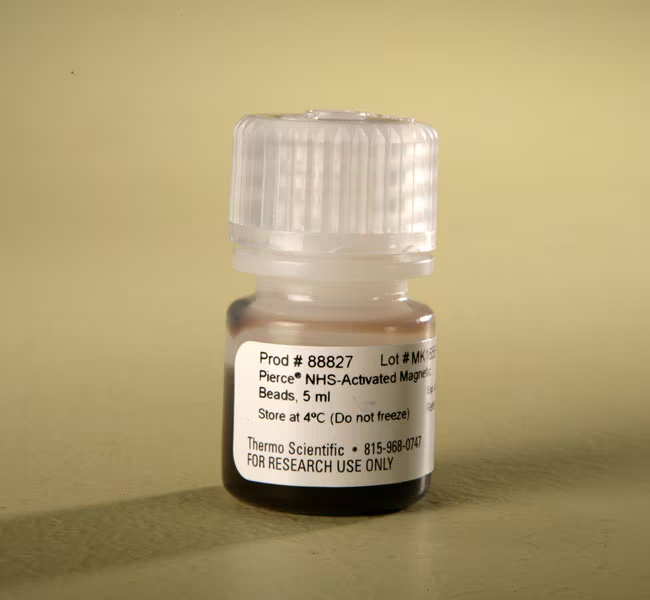
Thermo Scientific Pierce NHS-Activated Magnetic Beads enable covalent, amine-based conjugation of proteins to magnetic beads in a simple mix-and-go format for use in custom affinity purification experiments.
Features of NHS-Activated Magnetic Beads:
• High capacity—at least four times higher binding capacity than NHS-activated magnetic beads from other suppliers
• Easy to use—immobilize in a simple one-step reaction with minimal hands-on time
• Safe—no hazardous chemicals needed (e.g., sodium cyanoborohydride and cyanogen bromide)
• Ligand-compatible—use to immobilize with nearly any primary amine-containing compound or affinity ligand
• Low non-specific binding—the bead surface is pre-blocked and any nonreacted NHS-ester groups are fully quenched
• Protocol-compatible—protein coupling to the beads and downstream applications can be performed manually or by automation (e.g., Thermo Scientific KingFisher Instruments)
The activated magnetic beads contain N-hydroxy-succinimide (NHS) functional groups that react with primary amines forming stable amide linkages. Once they are covalently attached, the immobilized proteins are highly resistant to leaching from the bead surface. When prepared beads are used in experiments, nonspecific binding is negligible because nonreacted NHS-ester groups are thoroughly blocked during the coupling procedure. Pierce NHS-Activated Magnetic beads can be coupled and processed either manually with a magnetic stand or with automated platforms such as the Thermo Scientific KingFisher Instruments.
Applications:
• Immobilization of ligands for the purification of recombinant proteins
• Immobilization of antibodies for immunoprecipitations and co-immunoprecipitations free of antibody contamination in the eluates
• Immobilization of secondary antibody for the affinity purification of antibody subtypes from ascites, serum and cell culture supernatant
Pierce NHS-Activated Magnetic Beads offer a convenient way to conjugate any desired protein to a magnetic bead surface. The process does not require hazardous chemicals or lengthy reaction schemes. The beads are first incubated with protein for 1 to 2 hours in an amine free buffer at pH 7 to 9 to allow for covalent coupling through NHS-ester chemistry. The beads are subsequently washed and then any remaining active NHS-ester groups are quenched. The amine reactive chemistry and subsequent quench are completed in 3 to 4 hours. Coupled protein does not leach from the bead surface. In addition, the beads exhibit very low non-specific binding due to effective quenching and a proprietary blocking agent that coats the surface of the base particle. Following conjugation the prepared magnetic beads are typically used in affinity purification procedures.
| Code | Description |
|---|---|
| 88827 | Catalog Number: 88827 |
| 88826 | Catalog Number: 88826 |

